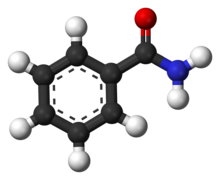Benzamide
Jump to navigation
Jump to search

| |

| |
| Names | |
|---|---|
| Preferred IUPAC name
Benzamide[1] | |
| Systematic IUPAC name
Benzenecarboxamide | |
| Other names
Benzoic acid amide
Phenyl carboxamide Benzoylamide | |
| Identifiers | |
3D model (JSmol)
|
|
| ChEBI | |
| ChEMBL | |
| ChemSpider | |
| ECHA InfoCard | 100.000.207 |
| EC Number | 200-227-7 |
| KEGG | |
PubChem CID
|
|
| RTECS number | CU8700000 |
| UNII | |
| |
| |
| Properties | |
| C7H7NO | |
| Molar mass | 121.139 g·mol−1 |
| Appearance | Off-white solid |
| Density | 1.341 g/cm3 |
| Melting point | 127 to 130 °C (261 to 266 °F; 400 to 403 K) |
| Boiling point | 288 °C (550 °F; 561 K) |
| 13 g/l | |
| Acidity (pKa) | |
| -72.3·10−6 cm3/mol | |
| Pharmacology | |
| N05AL (WHO) | |
| Hazards | |
EU classification (DSD) (outdated)
|
Harmful (Xn) |
| R-phrases (outdated) | R22 R40 |
| S-phrases (outdated) | S36/37/39 |
| NFPA 704 | |
| Flash point | 180 °C (356 °F; 453 K) |
| > 500 °C (932 °F; 773 K) | |
Except where otherwise noted, data are given for materials in their standard state (at 25 °C [77 °F], 100 kPa). | |
| Infobox references | |
Benzamide is an off-white solid with the chemical formula of C6H5CONH2. It is a derivative of benzoic acid. It is slightly soluble in water, and soluble in many organic solvents.
Chemical derivatives[edit]
A number of substituted benzamides exist, including:
- Analgesics
- Antidepressants
- Antiemetics/Prokinetics
- Alizapride
- Batanopride
- Bromopride
- Cinitapride
- Cisapride
- Clebopride
- Dazopride
- Itopride
- Metoclopramide
- Mosapride
- Prucalopride
- Renzapride
- Trimethobenzamide
- Zacopride
- Antipsychotics
- Opioids
- Others
- 3-Aminobenzamide
- Chidamide
- Denipride
- Entinostat
- Eticlopride
- Mocetinostat
- Procarbazine
- Pyramide (pyridinyl ethylbenzimide)[4]
- Raclopride
- Sunifiram
See also[edit]
References[edit]
- ^ Nomenclature of Organic Chemistry : IUPAC Recommendations and Preferred Names 2013 (Blue Book). Cambridge: The Royal Society of Chemistry. 2014. p. 841. doi:10.1039/9781849733069-FP001. ISBN 978-0-85404-182-4.
- ^ Haynes, William M., ed. (2016). CRC Handbook of Chemistry and Physics (97th ed.). CRC Press. p. 5–89. ISBN 978-1498754286.
- ^ Bordwell, Frederick G.; Ji, Guo Zhen (October 1991). "Effects of structural changes on acidities and homolytic bond dissociation energies of the hydrogen-nitrogen bonds in amidines, carboxamides, and thiocarboxamides". Journal of the American Chemical Society. 113 (22): 8398–8401. doi:10.1021/ja00022a029.
- ^ Singh, K. N. & Merchant, Kavita (2012). "The Agrochemical Industry, Annex 17.1". In Kent, James A. Handbook of Industrial Chemistry and Biotechnology. New York: Springer Verlag. pp. 643–698 page 693. doi:10.1007/978-1-4614-4259-2_17.
